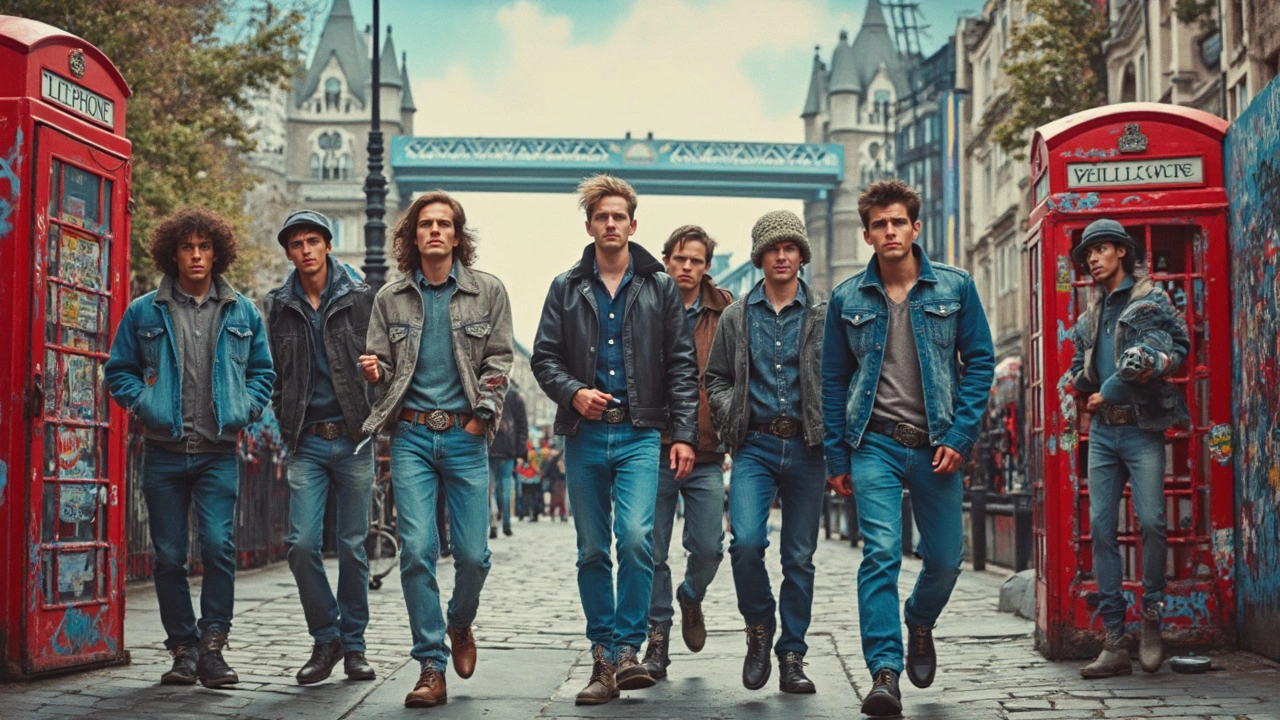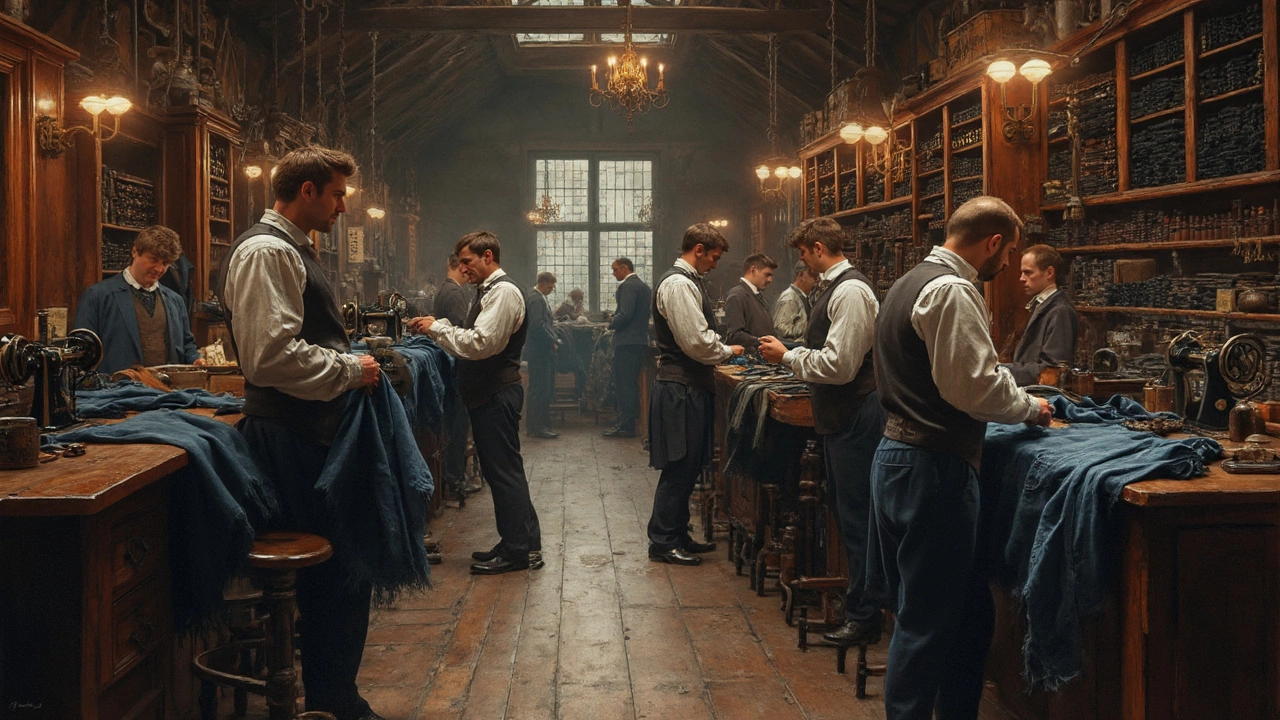Ripped knees, faded blue, and a patch on the back pocket—it’s hard to imagine a world before jeans. Yet, for more than a century, this humble workwear staple has ruled everything from cattle ranches to runways. Here’s a mind-blower: the original pair of Levi’s jeans was so prized that a 19th-century pair once sold at auction for over $100,000. That’s not just nostalgia; that’s denim royalty.
The Origin Story: From California Gold Dust to Global Denim
It all started during the California Gold Rush in the 1850s. Gold prospectors needed pants that could stand up to rough work, muddy rivers, and tough terrain. Enter Levi Strauss, a Bavarian immigrant who moved to San Francisco with a stack of canvas meant for tents and wagon covers. When a customer, tailor Jacob Davis, figured out how to rivet pocket corners to stop them from tearing, denim jeans as we know them were born in 1873. This innovative collaboration led to the first-ever blue jeans patent (US Patent No. 139,121), and the oldest jeans brand—Levi’s—was officially in business.
What’s wild is that Levi Strauss & Co. didn’t start with denim. They used brown canvas at first, but people craved something softer and more durable. Indigo-dyed cotton ‘serge de Nîmes’ (denim) from France fit the bill, and the classic blue jean look was set. Fast-forward to today, and denim is everywhere you look—ranging from Parisian runways to Tokyo streetwear.
Here’s a quirky twist: the first jeans were originally sold for men, especially miners and laborers. They only came with one back pocket and a watch pocket in the front. Women’s jeans didn’t make a proper debut until the 1930s, championed by lady rodeo riders and Western film stars. Levi’s introduced their first women’s jeans, Lady Levi’s 701, in 1934. Even then, jeans were seen more as rebellious leisurewear for women, not everyday fashion.
The craze was far from instant. For decades, jeans were pretty much just workwear. Jeans didn’t really become a youth or cultural obsession until Hollywood got involved. James Dean’s iconic jeans-and-T-shirt look in the 1955 film "Rebel Without a Cause" turned these work pants into symbols of rebellion—something any teenager in any era will instantly vibe with.
Wondering if your old jeans are worth something? Vintage Levi’s from before 1950, especially rare models like the 501XX, fetch thousands of dollars among collectors. Fun fact: Someone even found a pair of Levi's burrowed in a Nevada mining shaft from the 1880s, still intact, and they sold for $87,400 at auction in 2018.
The Giants of the Denim World: Who’s Who in Heritage Jeans
While Levi Strauss is the clear oldest, they started a trend that spawned a whole denim dynasty. Let’s get to know a few key players who’ve helped shape denim’s reputation:
- Levi Strauss & Co.: Founded in 1853 but made history with riveted blue jeans in 1873. Levi’s set the DNA for jeans—501s with a button fly, red tab, and arcuate stitching on the pockets. Still, to this day, the 501 range is seen as the “original.”
- Lee: Another iconic American brand, Lee was founded in 1889 in Kansas. The company was known for sturdy workwear and introduced the zip fly in 1926—a massive practical upgrade that became an industry standard.
- Wrangler: Hailing from North Carolina, Wrangler kicked off in 1947, aimed at rodeo cowboys. Their signature: flat rivets so saddles wouldn’t get scratched and a high back rise for comfort in the saddle. Think classic Western style.
- Big John (Japan): Japan wasn’t a denim hotspot until after WWII, but Big John revolutionized the local market in 1940s-1960s. Japanese denim now reigns supreme for quality and craft—brands like Edwin and Momotaro push heritage jeans even further.
Even with all the competition, no other jeans brand has managed to be quite as universally recognized—and worn—as Levi’s. A British survey in 2015 actually found that jeans are the most popular clothing item in the world. Not only are they durable, but they have the rare quality of looking better as they age, which never goes out of style.
Many brands have tried to mimic the Levi’s magic. Some have focused on luxury (think Gucci or Dior), while others double down on rugged wear and perfect fades, like Nudie or APC. The upshot? The basic blueprint from the 1800s hasn’t changed much. The secret is in the details—rivets, durable thread, and that snug, straight-leg cut.
If you’re into denim lore, there are also little-known legacy names like OshKosh B’gosh (1895) famous for overalls, and Blue Bell (1904), which later became Wrangler. But none of them nipped Levi’s at the origin story.

Fascinating Denim Facts—Legends, Myths, and Record Breakers
Weirdly, blue jeans have played a role far beyond fashion. In the 1950s, jeans were banned in schools and theaters in some U.S. towns for looking "rebellious" and "unchristian." In Russia during the Cold War, jeans were so coveted that a pair cost more than a month’s salary and folks literally smuggled them in.
Let’s bust a myth: "Denim" doesn’t come from "de Nîmes," the French city. Some historians argue the word stuck because fabric tailors in France used it for rugged trousers, and the legend just grew from there. Indigo, the blue dye, was another revelation—it comes from plants, and the deep shade was perfect for hiding stains. That’s why blue jeans held up better and looked cleaner after long days on site.
But there are also plenty of legends and odd tidbits people don’t often hear:
- In 1971, Levi’s swapped from the "LEVI’S" with a big "E" on the tab to a lowercase "e." Collectors hunt for those capital "E" tabs, known to indicate vintage pre-1971 pairs.
- One pair of jeans takes more than 1,800 gallons of water to make, mostly for growing cotton. That has spurred eco innovations like recycled denim and waterless dyeing.
- Elvis Presley was reportedly turned away from the Grand Ole Opry for showing up in jeans, which were seen as "too casual" for country music royalty at the time.
- The Guinness Book of World Records lists the largest pair of jeans at nearly 150 feet long, sewn together in Peru in 2019 as a stunt by a clothing retailer.
- People aren’t just obsessed now: jeans outrank yoga pants, khakis, and even sweatpants in most global wardrobe surveys.
For collectors, jeans value is in the details. Original rivets, selvedge (the tightly woven edges that won’t fray), and specific care labels can add huge value. Ever wanted to date your jeans? Stitching style, inner labels, and pocket shape give away their birth decade.
| Brand | Year Established | Notable Firsts | Main Audience |
|---|---|---|---|
| Levi Strauss & Co. | 1853 | First riveted jeans | Originally miners; now everyone |
| Lee | 1889 | First zip fly | Workwear, cowboys |
| Wrangler | 1947 | Western jeans, rodeo-friendly rivets | Ranchers, cowboys |
| Big John (Japan) | 1940s | Japanese selvedge denim | Denim collectors |
Today, jeans still shape style icons—celebs like Rihanna, Zendaya, and even Timothée Chalamet put their spin on them. But you can’t fake heritage: any true denimhead will tell you the best pairs still trace back to Levi’s roots. From gold-panning boomtowns to TikTok trends, these pants just don’t quit.
How to Spot Real Vintage Jeans—And Care for Iconic Denim
Let’s say you stumble on an old pair of Levi’s in your grandma’s attic or at a flea market. How do you know if you’ve hit denim gold? Here’s what sets the oldest jeans apart from the regular rack stuff:
- Selvedge edge: Flip the cuff. If the inner edge is tightly woven and often has a colored line, that’s classic, high-quality denim right there.
- Big “E” Levi’s tab: Pre-1971 Levi’s have a capital ‘E’ on the red tab. That alone gives away serious vintage status.
- Hidden rivets: On pre-1960s Levi’s, pocket rivets are covered inside the fabric so furniture and saddles wouldn’t get scratched. Super collectible!
- Cinch back waistband: Rare on modern jeans, this “buckle back” helped wearers tighten the waistband—common before belt loops showed up.
- Two-toned thread: Vintage jeans often switch color threads for seams and pockets, a mark of old-school manufacturing.
Preserving old jeans is actually easy, but people over-wash them. Denim is like a good cast iron pan—the more you wear it, the better it fits. Try spot cleaning, avoid hot water, and line dry. Want that perfect fade? Wear them often and only wash when truly needed.
Ever wondered how some people get such amazing fades on their jeans? It’s all about patience. Rigid, unwashed denim (called “raw” denim) shapes around your body, creating unique creases and color changes. Some denim heads go months—or even a year—before giving their jeans a proper wash, making the fade patterns one-of-a-kind.
If you want in on vintage jeans action, start small: check thrift shops, estate sales, or online vintage stores. Jeans from before the 1970s are already getting rare, and early Levi’s can be more precious than gold. Keep an eye out for anything with the classic tags or that solid, rigid feel—those pairs are built to last and worth hunting down.
Denim culture may be huge today, but it started with one simple idea: build sturdy pants that could survive anything. The fact that they grew into a worldwide obsession, making the leap from miners to pop stars, is a testament to great design—and stubborn fabric. Next time you slide into a pair of jeans, you’re wearing a little piece of rough-and-tumble history.

